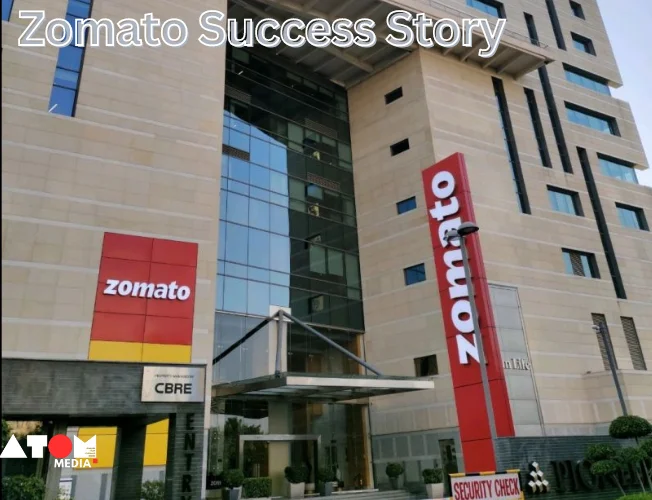Companies such as Zomato have revolutionised the food delivery landscape in a world where convenience is king. Zomato, which was founded in 2008 by Deepinder Goyal and Pankaj Chaddah, has revolutionised the food ordering experience by facilitating the delivery of mouthwatering meals from their preferred restaurants straight to customers’ doorsteps.
The Birth of Zomato
Zomato originated in the hallways of IIT Delhi, where Pankaj Chaddah and Deepinder Goyal had an idea for a platform that would make finding and ordering meals easier. The website, which was first known as Foodiebay, soon rose to prominence as Delhi NCR’s biggest restaurant directory. In 2010, the founders realised there was room for expansion and changed their name to Zomato, launching a global food tech company.
Mission and Vision
The simple but aspirational goal of Zomato is “to provide better food for more people.” This goal statement embodies the company’s dedication to elevating the eating experience by expanding the availability of high-quality meals to a wider demographic. Co-founder Pankaj Chaddah describes the goal as “to be the global platform when someone is looking for food locally.”
Services and Products
Zomato has diversified its offerings beyond just food delivery. Here are some of the key services and products that Zomato provides:
- Zomato Wings: By bringing restaurant owners and investors together, this platform makes it easier for the food industry to raise capital and grow.
- Zomato AI: An AI-enabled meal discovery partner that provides tailored suggestions according to dietary requirements and personal preferences.
- Zomato Future Foundation: This programme ensures that the children of Zomato delivery partners have access to high-quality education by supporting their education.
- Hyperpure: A business-to-business platform that enables eateries to buy premium products straight from growers and manufacturers.
- Zomato Gold: A subscription service that grants special advantages including complimentary delivery, VIP access during rush hours, and extra savings.
- Zomaland: An offline funfair that combines entertainment, music, and food to provide guests a fully immersive experience.
- Xtreme: In 2023, an app for package delivery was released that allowed retailers to send and receive tiny packages over Zomato’s vast delivery network.
Business and Revenue Model
Zomato’s business model is a blend of various revenue streams, making it a robust and diversified enterprise:
- Advertisement: By purchasing advertising space on Zomato’s platform, eateries may reach a wide audience of users.
- Commissions: Every order placed on Zomato’s platform incurs a commission fee.
- Memberships: Exclusive benefits are provided by the Zomato Pro (previously Zomato Gold) membership, which generates a consistent flow of income.
- B2B Services: Zomato’s business model gains a new dimension when high-quality ingredients are supplied to restaurants by platforms such as Hyperpure.
Challenges and Competitors
Like any other company, Zomato has faced its share of challenges:
- Market Competition: Constant innovation and strategic planning are needed to compete with other industry titans like Swiggy.
- Regulatory Obstacles: It might be difficult to navigate the intricate regulatory environment in many nations.
- Operational hurdles: There are constant hurdles in operating a large distribution network, ensuring timely delivery, and preserving food quality.
Despite these hurdles, Zomato has managed to stay ahead of the curve through strategic planning and innovation.
Funding and Acquisitions
Over the years, Zomato has raised significant capital, allowing it to expand and innovate continuously. Some notable funding rounds include:
- 2021: Raised $660 million in a Series J round led by Kora and Tiger Global Management.
- 2020: Secured $150 million from Ant Financial in a corporate round.
- Zomato has also made several strategic acquisitions to bolster its market position:
- Blinkit: Acquired for $725 million to enhance its delivery capabilities.
- Uber Eats India: Acquired for $206 million, expanding its customer base significantly.
Growth and Expansion
Zomato’s growth trajectory has shown remarkable results. Zomato started out small in Delhi NCR and has since grown to over 24 countries, serving over 10,000 cities. By 2023, Zomato processed millions of orders every day, had over 58 million consumers served, and had an average of 352,000 active delivery partners every month.
Future Plans
Looking ahead, Zomato aims to continue its global expansion while enhancing its technological capabilities. The focus will be on:
- Sustainability: Including environmentally friendly procedures in its daily activities.
- Technological Advancements: Increasing operational efficiency and user experience by utilising AI and machine learning.
- Expanding Services: To build a complete service ecosystem, diversifying into new verticals such as parcel services and supermarket delivery.
Final Thoughts
Zomato’s transformation from a small local restaurant directory to a massive international food delivery company is evidence of its creative thinking and unwavering commitment to quality. Zomato has not only brought tasty joy to people’s doorsteps all over the world by constantly changing and adjusting to market demands, but it has also raised the bar for the food tech sector. Zomato is in a good position to grow in the future and continue to provide happiness and convenience to millions of users worldwide.
Read more: Marketing News, Advertising News, PR and Finance News, Digital News, Startup





